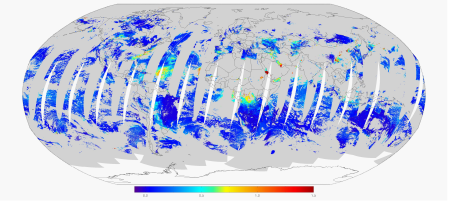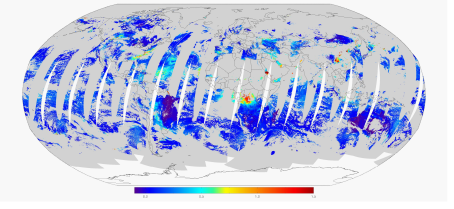STAR / SMCD / EMB Aerosol Remote Sensing
NPP / JPSS VIIRS Research
 |
| VIIRS AOD |
The aim of the research is to evaluate and test the VIIRS aerosol algorithm and resulting aerosol products with emphasis on the identification of error sources, and with the expectation of a detailed estimate of the error budget, and understanding of error sources. Performance (accuracy and precision) is evaluated as a function of observing geometry and scene type including surface reflectance and aerosol type. The VIIRS Aerosol Algorithm is evaluated under a large variety of realistic conditions. To this end, MODIS data as input to the operational VIIRS aerosol algorithm are used to derive aerosol optical depth (AOD), aerosol particle size parameter (APSP), and suspended matter (SM). The results are evaluated by comparing them with MODIS-derived and ground-observed (AERONET) AOD and APSP. This permits thorough testing of the algorithm in real operational processing.
Algorithm Development and Evaluation
VIIRS algorithm with MODIS data as proxy
The operational VIIRS algorithm was modified to run with MODIS data. The changes were necessary because the VIIRS aerosol algorithm contains routines that were specifically designed for the VIIRS spectral bands. These routines include the estimation of surface reflectances in bands 3 and 5 (0.488 µm and 0.672 µm) from that in the near infrared band, and the correction of top of atmosphere radiances for gaseous absorption. In order to directly use the MODIS radiances in the algorithm the appropriate modules were replaced with ones that are based on the MODIS bands. The look-up-table appropriate for the MODIS spectral bands using the VIIRS aerosol models and Mie calculations was also calculated.
 |
| MODIS AOD |
Cross validation with MODIS aerosol retrieval
One year of global C5 MOD04 cloud-screened, gas-absorption-corrected, spatially-filtered/averaged MODIS reflectances were used in the appropriately modified VIIRS aerosol algorithm. Use of these reflectances directly in the VIIRS algorithm (bypassing gas absorption correction) avoids sampling differences and makes a direct comparison between the VIIRS and MODIS algorithms possible. The time series of daily global, and land vs. ocean AOD retrievals were examined and compared to those in the C5 MOD04 product. It was found that global AOD was underestimated by VIIRS relative to MODIS year round, but especially in September. Overestimation in NH (spring) and underestimation in SH (Sep) was observed over land. Over ocean, VIIRS underestimated the AOD in both hemispheres.
For more details, contact Dr. Istvan Laszlo (Principal Investigator), NOAA/NESDIS/STAR (e-mail) and Dr. Hongqing Liu co-principal investigator), I. M. Systems Group Inc. (IMSG). (e-mail).
